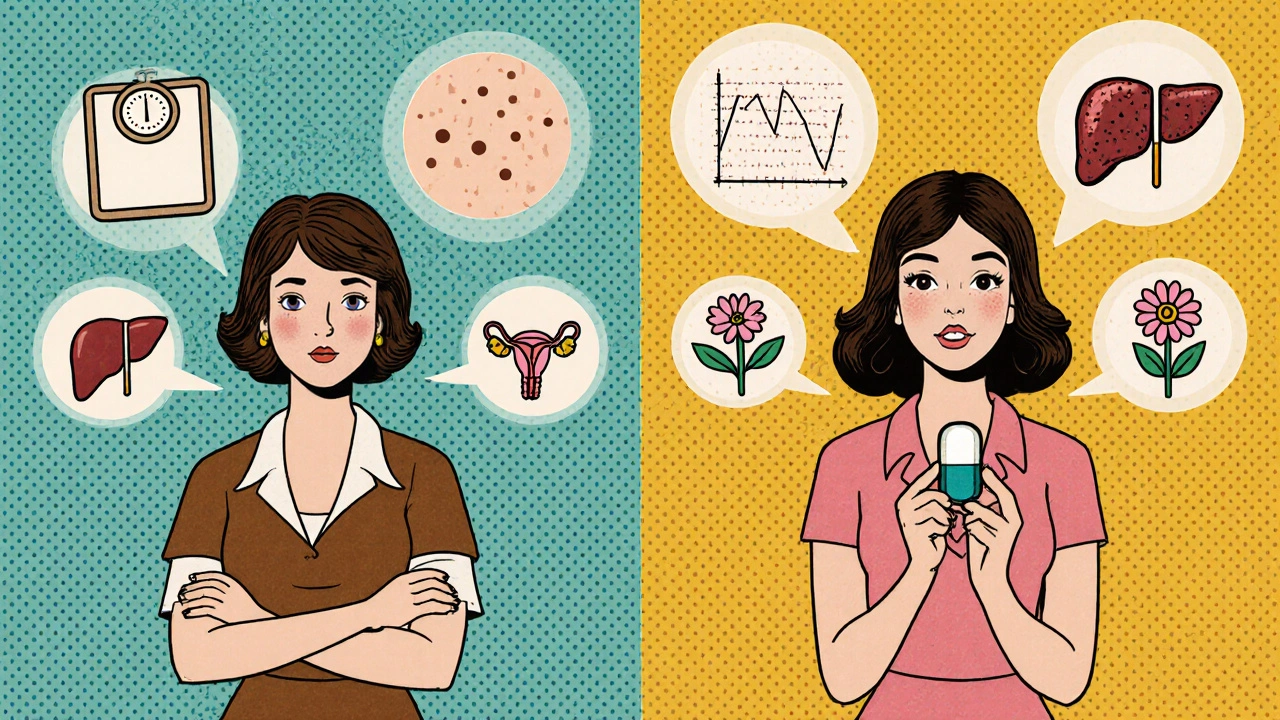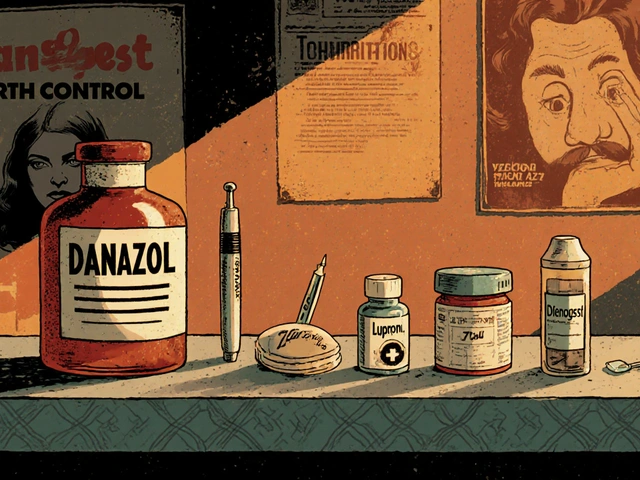Endometriosis Treatment Decision Tool
Find Your Best Treatment Option
This tool helps you understand which treatment might be most appropriate for your specific situation based on priorities and medical history.
Danazol isn’t a drug most people know by name, but for those dealing with endometriosis or severe fibrocystic breast disease, it’s been a lifeline - and a last resort. It’s not gentle. It doesn’t come with a gentle warning label. It’s a synthetic steroid that shuts down your body’s natural hormone production, and that comes with side effects: weight gain, acne, voice deepening, mood swings, and sometimes liver stress. But for some women, when nothing else works, Danazol does. The question isn’t just whether it works - it’s whether there’s something better.
How Danazol Actually Works
Danazol isn’t an estrogen blocker. It’s not a birth control pill. It’s a modified testosterone derivative that tricks your brain into thinking your ovaries are already producing too much hormone. Your pituitary gland shuts down signals to your ovaries, and estrogen levels drop - fast. That’s why it works: endometriosis thrives on estrogen. Fibrocystic breast pain? Also estrogen-driven. Lower estrogen, and symptoms often fade.
But here’s the catch: your body doesn’t know the difference between fake signals and real ones. When estrogen drops, so do your natural progesterone and other hormones. That’s where the side effects come from. A 2023 study in the European Journal of Obstetrics & Gynecology found that 68% of women on Danazol reported at least one moderate to severe side effect within six months. That’s why doctors now hesitate to prescribe it unless everything else has failed.
Alternative #1: GnRH Agonists (Lupron, Zoladex)
If Danazol feels like a sledgehammer, GnRH agonists are more like a precision tool. These drugs - leuprolide (Lupron), goserelin (Zoladex) - work the same way as Danazol: they shut down ovarian estrogen production. But they do it more cleanly, without the androgenic side effects. No acne. No voice changes. No facial hair.
They’re injected monthly or implanted under the skin. Treatment usually lasts 6 months, then stops. That’s because long-term use causes bone density loss. That’s why doctors pair them with add-back therapy - low-dose estrogen and progestin - to protect bones while keeping endometriosis in check.
Compared to Danazol, GnRH agonists have fewer physical side effects but higher costs. A full course of Lupron can run over £2,000 in the UK without insurance. Danazol? Around £150 for a three-month supply. But if you’re a 28-year-old teacher worried about gaining 15 pounds or growing a beard, the cost of GnRH agonists might be worth it.
Alternative #2: Progestins (Norethindrone, Dienogest)
These are the quiet workhorses of endometriosis treatment. Dienogest (Visanne) is approved in the UK specifically for endometriosis. It’s a progestin that doesn’t suppress ovulation as hard as Danazol, but still shrinks endometrial tissue. It’s taken daily as a pill. Side effects? Spotting, headaches, mood changes - but nothing like Danazol’s androgenic punch.
A 2022 Cochrane review found dienogest as effective as Danazol in reducing pelvic pain, but with significantly fewer adverse events. Women on dienogest reported less weight gain, no acne, and no changes in voice. It’s not perfect - some women get depressed on it - but it’s far more tolerable.
Norethindrone is cheaper and older, often used off-label. It’s not as targeted as dienogest, but it’s widely available and covered by the NHS. If you’re looking for a low-cost, low-impact option, progestins are the first place to look.

Alternative #3: Combined Oral Contraceptives (COCs)
Most women with endometriosis start here - and for good reason. Birth control pills suppress ovulation and thin the uterine lining. That reduces bleeding and pain. Continuous use (skipping the placebo week) is even more effective.
They don’t shrink existing endometrial implants like Danazol does, but they stop new growth. For mild to moderate cases, COCs are often enough. A 2021 trial in Fertility and Sterility showed that 72% of women on continuous COCs reported improved pain within 3 months. No voice changes. No liver enzymes to monitor. Just a daily pill.
But they’re not for everyone. Women with migraines with aura, blood clot risks, or uncontrolled high blood pressure can’t use them. And if your endometriosis is advanced - stage 3 or 4 - COCs alone won’t cut it. That’s where Danazol or GnRH agonists come in.
Alternative #4: Aromatase Inhibitors (Letrozole, Anastrozole)
This is the newest frontier. Aromatase inhibitors block the enzyme that turns androgens into estrogen - even in fat tissue. That means estrogen drops everywhere, not just in the ovaries. They’re not FDA-approved for endometriosis, but UK specialists use them off-label, especially in postmenopausal women or those who’ve had surgery and still have pain.
Used with progestins or COCs to protect the uterus, letrozole can be powerful. One small 2023 study from Manchester Royal Infirmary followed 32 women with recurrent endometriosis after surgery. Half got letrozole plus norethindrone. After 6 months, 81% had no pain recurrence. Only 18% of the control group (on norethindrone alone) did.
The downside? Bone density loss, joint pain, and hot flashes. It’s not a first-line option. But for women who’ve tried everything else - including Danazol - and still have pain, it’s a real contender.
Alternative #5: Surgery (Laparoscopic Excision)
Here’s the truth no one says out loud: Danazol and all the hormonal alternatives treat symptoms. They don’t cure endometriosis. Only surgery can remove the lesions - if they’re visible and accessible.
Laparoscopic excision, done by a specialist, cuts out the endometrial tissue like removing a stain from fabric. It’s not a quick fix - recovery takes weeks - but for many, it’s the only path to long-term relief. A 2024 study from the Royal College of Obstetricians and Gynaecologists showed that 78% of women who had complete excision reported no pain after 12 months, compared to 41% on Danazol alone.
Surgery isn’t a replacement for medication. It’s often paired with it. After excision, doctors often prescribe dienogest or COCs to prevent regrowth. Danazol? Rarely used after surgery - it’s too harsh for maintenance.

When Danazol Still Makes Sense
Let’s be honest: Danazol is rarely the best choice. But it’s not obsolete. There are still cases where it’s the only option.
- You can’t afford GnRH agonists or dienogest (both are expensive).
- You’ve tried COCs and progestins - no improvement.
- You’re not a candidate for surgery (due to health risks or access issues).
- You’re postmenopausal and have severe fibrocystic breast disease that won’t respond to anything else.
In those cases, Danazol can be a bridge - a short-term solution. Doctors usually prescribe it for 3-6 months, then switch you to something safer. It’s not a lifestyle drug. It’s a crisis drug.
What to Ask Your Doctor
If you’re on Danazol or considering it, here’s what you need to talk about:
- Have I tried all first-line options? (COCs, progestins)
- What’s my endometriosis stage? (Mild cases rarely need Danazol)
- Can I afford or access alternatives like dienogest or GnRH agonists?
- Am I at risk for liver problems or blood clots? (Danazol can raise liver enzymes and LDL cholesterol)
- Do I plan to get pregnant soon? (Danazol causes birth defects - you must use reliable contraception)
Don’t accept Danazol because it’s the first thing your doctor mentioned. Push for a plan. Ask for a timeline. If you’re on it for more than 6 months without improvement, it’s time to reassess.
The Bottom Line
Danazol works - but it’s the old-school way. Modern medicine has better tools. Dienogest is safer. GnRH agonists are more targeted. COCs are easier. Surgery can be curative. Aromatase inhibitors are emerging as powerful tools for stubborn cases.
There’s no single best alternative. It depends on your symptoms, your budget, your goals, and your tolerance for side effects. But one thing’s clear: you don’t have to live with Danazol’s side effects if you haven’t explored everything else. Ask for options. Push for a plan. And don’t let outdated thinking keep you on a drug that was designed for a different era.







Write a comment
Your email address will be restricted to us